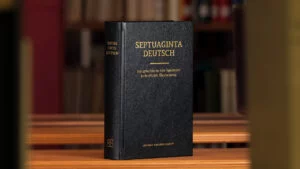Septuagint (LXX)


The Septuagint edition by Alfred Rahlfs has been an important basis of worldwide Septuagint research ever since it was first published in 1935. This edition was revised by the internationally renowned Septuagint researcher Robert Hanhart in 2006; in the course of this work, the text and apparatus were corrected and extended in well over a thousand instances.
In early 2009, the first complete German-language translation of the Septuagint was published by the German Bible Society under the title “Septuaginta Deutsch”. This translation of the Bible with a rich tradition was thus made available to a broad readership for the first time.
The autonomous nature of the Septuagint
Although it evolved in a gradual process, the Septuagint does not simply depend on the existing Hebrew portion of the holy scriptures as we know it, since the inventory of the Hebrew scriptures likewise only acquired definitive form in the 3rd/2nd centuries BC, and the portion beyond the Pentateuch and the Prophets even later. The Hebrew Bible and the Septuagint thus developed in parallel in a complicated process. As a comparison of Greek and Hebrew textual recensions shows, the Septuagint is based on an autonomous, in part even older Hebrew text than that which was later to attain canonic validity among Jewry.
As a result of the discoveries in Qumran, the Hebrew equivalent of the passages that deviate from the Masoretic Text in the Septuagint is now known for some of the books of the Bible. On the other hand, the Greek Dead Sea Scrolls testify that an initial revision of the existing Greek translations was already undertaken prior to the Christian era: The Septuagint text began to be adapted to the then valid Hebrew text.
The significance of the Septuagint for the New Testament
For the New Testament, the Septuagint – as the collection of Holy Scriptures – holds at least as much significance as the Hebrew text: For the first Greek-speaking Christians, the Septuagint was the Holy Scripture. The authors of the New Testament founded their citations from the Old Testament more on the Septuagint than on the Hebrew (and the Aramaic) text, even when they – for example Paul or John – were presumably familiar with the Hebrew text. The Greek Old Testament text thus plays a crucial role in the interpretation of passages from the New Testament.
In the course of the parting of the ways of Christianity and Jewry, the Septuagint became more and more established as the Holy Scripture of the church. In fact some translators (Aquila, Theodotion) endeavored once more to create a Greek translation for Jewry in the second century. However, in the course of time, the Jewish rabbis fundamentally rejected to an increasing extent a Greek translation of the Torah. In the church, on the other hand, only a small number of scholars (Origenes, Hieronymus) were still familiar with the Hebrew text from their own reading; it no longer played a role in the practice of the (Western) churches. It was only the humanists of the early 16th century who rediscovered it for Western Christianity – above all for the churches of the Reformation. For Oriental and Byzantine Christianity, the Septuagint remains the definitive text of the Old Testament.


